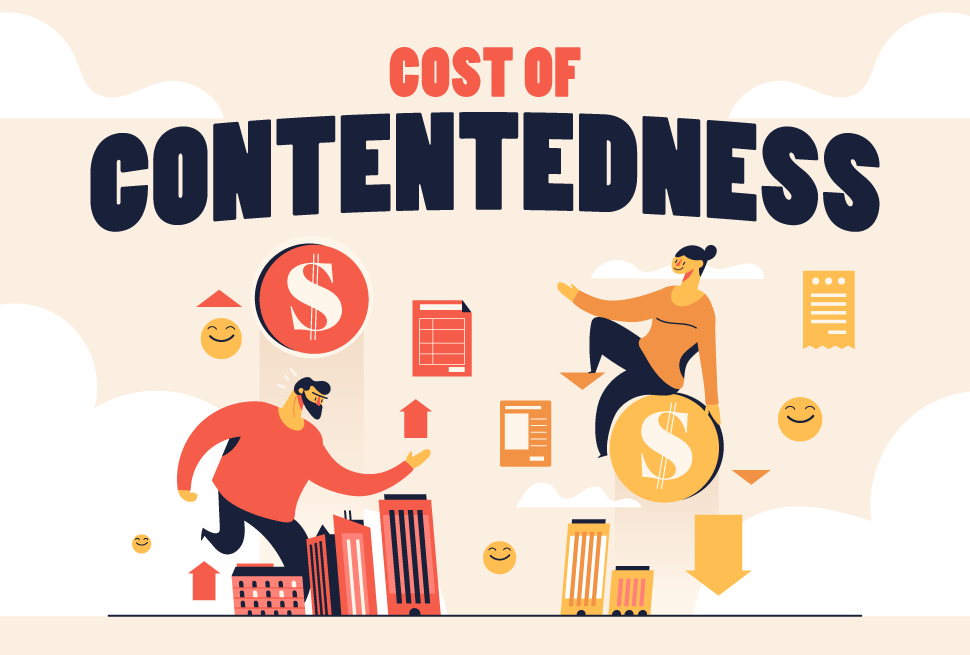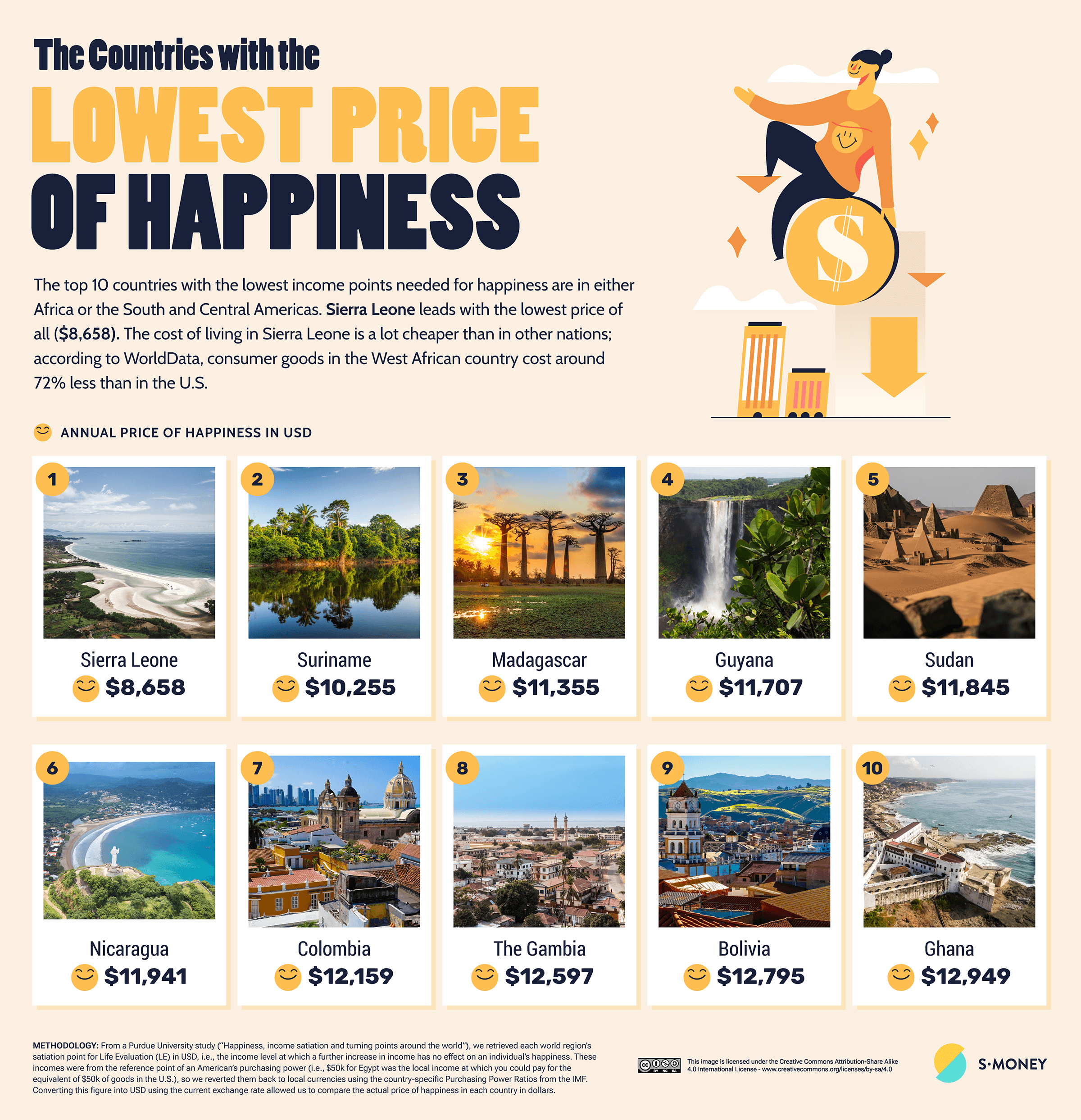
It’s not what you earn; it’s the way that you spend it — that’s what leads to happiness.
So claim the authors of a Harvard-affiliated study that proposed eight principles to “help consumers get more happiness for their money.” Eight principles that begin with “(1) buy more experiences and fewer material goods” and end with “(8) pay close attention to the happiness of others.”
Whether these techniques work or not, they add an important sense of quotidian nuance to what has become a rather academic debate about how much money you need to be happy.
Notice that this ancient question is now framed not as “Can money make you happy?” but “How much to make you happy?” A 2010 study by Daniel Kahneman and Angus Deaton drew the line under the first question. Kahneman and Deaton concluded that a greater income equals a greater objective sense of accomplishment and that money boosts emotional well-being — but only up to an annual income of $75,000 or so per individual (not per household). Beyond that, extra dollars do not equal extra happiness.
Kahneman’s study was based on U.S. survey responses. But a 2018 study from Purdue University identified a similar “satiation point” of $60-75,000 as a global average, based on Gallup World Poll figures from over 1.7 million people in 164 countries.
Crucially, the Purdue researchers found that “there was substantial variation across world regions, with satiation occurring later in wealthier regions for life satisfaction.” The researchers believed that this data could help individuals to reassess their personal values and ambitions, employers to compensate employees at more appropriate rates and governments to better legislate towards fair wealth distribution.
But for a more practical, day-to-day look at how money might affect happiness, S Money decided to convert the Purdue study’s figures back into their local currencies — this time, allowing for purchasing power and the local cost of living. Because if what you buy shapes your happiness as much as how much you earn, then your happiness per dollar depends greatly on where in the world you’re spending it.
What We Did
S Money sourced each world region’s satiation point for Life Evaluation (LE) in USD, i.e., the income level at which a further increase in income has no effect on an individual’s happiness, from a Purdue University study called Happiness, income satiation and turning points around the world. To find what these satiation points mean in real terms — the relationship between local paychecks and local shops — we reverted them back to local currencies using the country-specific Purchasing Power Ratios from the IMF.
Key Findings
- Iran has the highest cost of happiness in the world, requiring an annual income of $239,700.
- Happiness is most affordable in Sierra Leone, Africa, where happiness levels off with an income of $8,658.
- Santa Barbara (CA) is the American city with the highest cost of happiness: $162,721.
- Knoxville (TN) is the American city with the lowest cost of happiness: $88,032.
- In the UK, the top and bottom cities are London ($103,083) and Leicester ($79,188).

Iran and Norway Among Most Expensive Countries to Be Happy
Purdue’s researchers found that around the world, emotional well-being levels off at a certain level of income — and even dips a little just after that level is reached. However, they also found that “there was substantial variation across world regions, with satiation occurring later in wealthier regions for life satisfaction,” according to lead author Andrew T. Jebb. “This could be because evaluations tend to be more influenced by the standards by which individuals compare themselves to other people.” Here are the countries where the price of happiness is highest and lowest.

Some of the world’s highest-earning countries are among those with the highest price of happiness, as you might expect. Norway is one of the world’s highest-income countries — helping its citizens to become among the happiest on Earth, according to various reports over the years. But it is not just individual income that keeps Norwegians chipper: the economic safety net of social security helps its citizens to sleep better at night, even when that night starts in the middle of the day during the dark Scandinavian winter.
Meanwhile, New Zealand and Israel suffer a high cost of happiness despite not being among the top earners. And top-placed Iran, over half the population lives below the poverty line, with one in nine living on less than $5.50 a day. Meanwhile, inflation in Iran was at around 47.7% in February of this year, with the price of regular daily goods rising dozens of times over — suggesting that the high price of happiness is more due to economic than cultural reasons.

Coastal U.S. Cities Set Highest Price for Happiness
The price of happiness leaps by 85% between the U.S. city where happiness is most affordable (Knoxville, Tennessee, $88,032) and the one where it costs the most (Santa Barbara, California, $162,721). This difference is based on the cost of living in U.S. cities as indexed on Numbeo. Coastal cities like Santa Barbara endure a higher cost of living — ergo of happiness — due to the concentration of both high population numbers and wealth.

As the New York Times puts it: “Major coastal metros have been hubs of the kind of educated workers coveted most by high-powered employers and economic development officials.”
But are these ‘coastal elites’ truly happy? Well, yes, according to a recent survey of 450,000 U.S. adults by digital health company Sharecare: San Francisco, San Jose and Washington D.C. are the three happiest cities in the U.S. despite each being among the 12 cities we found to have the highest price of happiness.
Happiness Costs More in the South of the UK
The price of happiness from UK city to city is not so disparate as in the United States — although the affordability of happiness may vary greatly within cities as well as between them. For example, London has the highest cost of living and most substantial price tag on happiness — but with the city’s wealthiest 10% controlling 44.3% of the city’s net wealth and the poorest 50% holding just 5.9%, happiness (or the peace of mind required to achieve it) is permanently out of the grasp for most Londoners.

In general, the south is not a happy place to be unless you are a higher-tier earner: eight out of the ten cities with the highest price of happiness are south of Birmingham. Incidentally, the Birmingham brand of happiness is a relatively affordable $80,855, and the city boasts a suburb built for chocolate makers, which is happier and “twice as pleasant” than the rest of the UK — and that’s according to a rival confectionery brand!
Who Finds A Friend, Finds A Treasure
Despite our findings, simply upping sticks and moving to a place where happiness is cheap may not be the wisest idea.
“Money can’t buy us happiness,” says Marc Schulz, an Associate Director of the Harvard Study of Adult Development, “but it’s a tool that can give us security and safety and a sense of control over our lives. At the end of the day, life is really about our connections with others. It’s our relationships that keep us happy.”
However, if your connections with others are not offsetting your economic costs, you can check our full data below to find a city with more affordable off-the-peg smiles.
Schulz also reminds us that a job that earns you big bucks is not necessarily the most efficient career path to happiness either:
“A large part of our waking lives is spent at work, and if you believe that relationships make for a good life, then you need to think about your connections at work. Those relationships are important to your well-being, because you spend such a large amount of time with them.”
Perhaps happiness doesn’t depend so much on how you spend your money than with whom you earn and spend it.
METHODOLOGY & SOURCES
We started by reverse-engineering figures obtained from Purdue University’s study into the relationship between happiness and income to discover the price of happiness in every country and select cities.
First, we referred to table one of the study and recorded the satiation point for Life Evaluation (LE) in USD for each world region. Life Evaluation is a metric from the World Gallup poll that measures how good an individual considers their life to be. The satiation point of LE refers to the income point at which any further increase in income has no effect on an individual’s happiness.
The figures in the study grouped countries into world regions and quoted the satiation points relative to an American’s purchasing power. So, to discover the local price of happiness by country, we converted these figures back to local currencies using country-specific Purchasing Power Ratios sourced from the International Monetary Fund. Purchasing power ratios represent the number of units of local currency that are equal to the buying power of one U.S. dollar in the United States.
Finally, we converted local currencies back into U.S. dollars using current exchange rates given by Google Finance. This is the price of happiness.
In addition, we calculated the price of happiness for select cities within each country by adjusting the country price of happiness according to the cost of living value for both cities and countries in Numbeo’s index.
The data of this analysis is correct as of July 2023.

